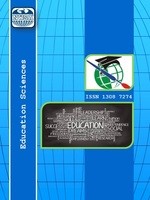DEVELOPMENT AND CURRENT STATUS OF EDUCATION RESEARCHES ON VISUALS IN TURKEY
Visualisation, Visual materials, Education, Education Researches, Document Analysis
___
- Eilks, I., Witteck, T., and Pietzner, V., (2012). The role and potential dangers of visualisation when learning about sub- microscopic explanations in chemistry education. CEPS Journal, 2 (1): 125-145.
- Zimmerman, W. and Cunningham, S., (1991). Editor’s introduction: what is mathematical visualization? In W. Zimmerman and S. Cunningham (eds.), Visualization in teaching and learning mathematics (pp. 1-8). Mathematical Association of America, MAA Notes Series.
- El-Tigi, M.A., Lewis B.A., and Mac Entee, V.M., (1996). Perception of elementary students of visual on the web. (Report no. IR018362). (ED408949). Paper presented in Annual Conference of the Visual Literacy Association, 28 October 1996, Cheyenne, Wyoming.
- Kabapınar, F., (2003). An examination of visuals in Turkish and English science and chemistry textbooks from the point of view of constructivist, Hacettepe University Journal of Education, 25: 119-126.
- Prosser, J., (2007). Visual methods and the visual culture of schools, Visual Studies, 22 (1): 13-30.
- Davenport, J.L., Klahr, D., and Koedinger, K., (2007). The influence of molecular diagrams on chemistry learning. European Association for Research on Learning and Instruction. http://oli.web.cmu.edu/openlearning/ files/theinitiative/publications/davenportearli07.pdf
- Butcher, K.R., (2006). Learning from text with diagrams: Promoting mental model development and inference generation, Journal of Educational Psychology, 98(1):182–97.
- Mayer, R.E. and Anderson, R.B., (1992). The instructive animation: Helping students build connections between words and pictures in multimedia learning, Journal of Educational Psychology, 8: 444-452.
- Krippendorff, K., (2004). Content analysis- an introduction to its methodology. Sage Publications, United States of America.
- Ainsworth, Nathen and Meter, (2010). Learning about Dynamic Systems by Drawing. Accessed at http://www.psychology.nottingham.ac.uk/staff/sea/drawing_icls_20 10.pdf on 2th July 2102
- Çalık, M., Ünal, S., Coştu, B., and Karataş, F.Ö., (2008). Trends in Turkish Science Education, Essays in Education, Special Edition, 23-46.
- Duit, R. and Glynn, S.M., (1995). Analogien-brücken zum verständnis. (Analogies--Bridges to understanding), Naturwissenschaften im Unterricht--Physik, 27(6), 4-10.
- Mathewson, H.J., (2005). The visual core of science: definition and applications to education, International Science Education, 27 (5): 529-548.
- Burmark, L., (2002). Visual Literacy: Learn to see, see to learn. Association for Supervision and Curriculum Development Press, VA.
- Segun, M., (1988). The Importance of illustrations in children’s books” in Mabel Segun (eds), Illustrating for children (pp 25- 27). Ibadan: CLAN.
- Atmaca, E.A., (2006). Illustartion and visual design in elemetary school books, National Education, 171: 318-327.
- Shieh, R. S., Chang, W. & Tang, J. (2010). The impact of implimenting technology-enabled active learning (teal) in university physics, The Asia-Pasific Education Reseacher, 19 (3): 401-415.
- Umdu Topsakal, U. and Oversby, J., (2011). Turkish student teachers’ ideas about diagrams of a flower and a plant cell, Journal of Biological Education. DOI:10.1080/00219266.2011.572988
- Başlangıç: 2009
- Yayıncı: E-Journal of New World Sciences Academy
SINIF ÖĞRETMENİ ADAYLARININ YANSITICI DÜŞÜNME BECERİLERİNE İLİŞKİN GÖRÜŞLERİ
BİYOLOJİ ÖĞRETMEN ADAYLARININ ÇEVREYE YÖNELİK TUTUMLARI VE ÇEŞİTLİ DEĞİŞKENLER AÇISINDAN İNCELENMESİ
KAMU PERSONELİ SEÇME SINAVI NEDENİYLE ÖĞRETMEN ADAYLARINDA OLUŞAN STRESLE BAŞA ÇIKMA YÖNTEMLERİ
AN INVESTIGATION OF INSTRUCTIONAL ENVIRONMENT IN KINDERGARTEN CLASSROOMS
BİR EĞİTİM PROGRAMININ NASIL OLMASI GEREKTİĞİNE İLİŞKİN ÖĞRETMEN ADAYI İNANÇLARI
MATEMATİKTE ÖZ DÜZENLEYİCİ ÖĞRENME STRATEJİLERİ ÖLÇEĞİNİN GEÇERLİK VE GÜVENİRLİK ÇALIŞMASI
DEVELOPMENT AND CURRENT STATUS OF EDUCATION RESEARCHES ON VISUALS IN TURKEY
Sinem TORAMAN, Ünsal Umdu TOPSAKAL
SINIF ÖĞRETMENİ ADAYLARININ “SANAT EĞİTİMİ DERSİ” KAVRAMINA İLİŞKİN METAFORLARI
ÖĞRETMEN ADAYLARININ âKENDİNİ GERÇEKLEŞTİRMEâ BAĞLAMINDA KİŞİSEL YÖNELİMLERİNİN İNCELENMESİ
